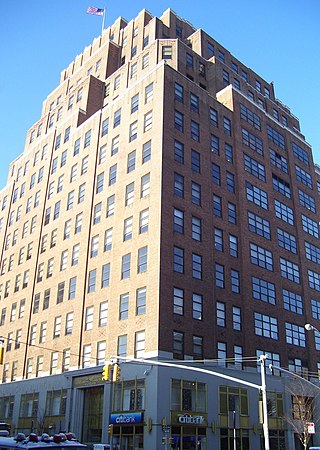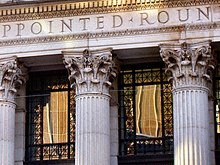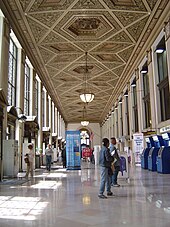
Madison Square Garden, colloquially known as the Garden or by its initials MSG, is a multi-purpose indoor arena in New York City. It is located in Midtown Manhattan between Seventh and Eighth Avenues from 31st to 33rd Street above Pennsylvania Station. It is the fourth venue to bear the name "Madison Square Garden"; the first two, opened in 1879 and 1890 respectively, were located on Madison Square, on East 26th Street and Madison Avenue, with the third Madison Square Garden (1925) farther uptown at Eighth Avenue and 50th Street.

Pennsylvania Station is the main intercity railroad station in New York City and the busiest transportation facility in the Western Hemisphere, serving more than 600,000 passengers per weekday as of 2019. The station is located beneath Madison Square Garden in the block bounded by Seventh and Eighth Avenues and 31st and 33rd Streets and in the James A. Farley Building, with additional exits to nearby streets, in Midtown Manhattan. It is close to several popular Manhattan locations, including Herald Square, the Empire State Building, Koreatown, and Macy's Herald Square.

Grand Central Terminal, is a commuter rail terminal located at 42nd Street and Park Avenue in Midtown Manhattan, New York City. Grand Central is the southern terminus of the Metro-North Railroad's Harlem, Hudson and New Haven Lines, serving the northern parts of the New York metropolitan area. It also contains a connection to the Long Island Rail Road through the Grand Central Madison station, a 16-acre (65,000 m2) rail terminal underneath the Metro-North station, built from 2007 to 2023. The terminal also connects to the New York City Subway at Grand Central–42nd Street station. The terminal is the third-busiest train station in North America, after New York Penn Station and Toronto Union Station.

The Times Square–42nd Street station is a major New York City Subway station complex located under Times Square, at the intersection of 42nd Street, Seventh Avenue, and Broadway, in Midtown Manhattan. The complex allows free transfers between the IRT 42nd Street Shuttle, the BMT Broadway Line, the IRT Broadway–Seventh Avenue Line and the IRT Flushing Line, as well as to the IND Eighth Avenue Line a block west at 42nd Street–Port Authority Bus Terminal. The complex is served by the 1, 2, 3, 7, N and Q trains at all times, the W train during weekdays; the R and 42nd Street Shuttle (S) trains at all times except late nights; and <7> trains during rush hours in the peak direction. A free passageway from the shuttle platform to the 42nd Street–Bryant Park/Fifth Avenue station, served by the 7, <7>, B, D, F, <F>, and M trains, is open during the day from 6 a.m. to 12 a.m.

34th Street is a major crosstown street in the New York City borough of Manhattan. It runs the width of Manhattan Island from West Side Highway on the West Side to the FDR Drive on the East Side. 34th Street is used as a crosstown artery between New Jersey to the west and Queens to the east, connecting the Lincoln Tunnel to New Jersey with the Queens–Midtown Tunnel to Long Island.

Penn 1 is a skyscraper in New York City, located between 33rd Street and 34th Street, west of Seventh Avenue, and adjacent to Pennsylvania Station and Madison Square Garden. It is the tallest building in the Pennsylvania Plaza complex of office buildings, hotels, and entertainment facilities.

The Hearst Tower is a building at the southwest corner of 57th Street and Eighth Avenue, near Columbus Circle, in the Midtown Manhattan neighborhood of New York City, United States. It is the world headquarters of media conglomerate Hearst Communications, housing many of its publications and communications companies. The Hearst Tower consists of two sections, with a total height of 597 feet (182 m) and 46 stories. The six lowest stories form the Hearst Magazine Building, designed by Joseph Urban and George B. Post & Sons, which was completed in 1928. Above it is the Hearst Tower addition, which was completed in 2006 and designed by Norman Foster.

34th Street–Penn Station is an express station on the IND Eighth Avenue Line of the New York City Subway, located at the intersection of 34th Street and Eighth Avenue in Midtown Manhattan. It is served by the A and E trains at all times, and by the C train at all times except late nights. The station is adjacent to Pennsylvania Station, the busiest railroad station in the United States as well as a major transfer point to Amtrak, NJ Transit, and the Long Island Rail Road.

The David N. Dinkins Municipal Building is a 40-story, 580-foot (180 m) building at 1 Centre Street, east of Chambers Street, in the Civic Center neighborhood of Manhattan in New York City. The structure was built to accommodate increased governmental space demands after the 1898 consolidation of the city's five boroughs. Construction began in 1909 and continued through 1914 at a total cost of $12 million.

The Hotel Pennsylvania was a hotel at 401 Seventh Avenue in Manhattan, across from Pennsylvania Station and Madison Square Garden in New York City. Opened in 1919, it was once the largest hotel in the world. It remained the fourth largest in New York City until it closed permanently on April 1, 2020. After years of unsuccessful preservation battles, it was demolished in 2023. The hotel is to be replaced by 15 Penn Plaza, a 68-story tower.

Penn South, officially known as Mutual Redevelopment Houses and formerly Penn Station South, is a limited-equity housing cooperative development located between Eighth and Ninth Avenues and West 23rd and 29th Streets, in the Chelsea neighborhood of Manhattan in New York City. The complex has 2,820 units in ten 22-story buildings. Penn South is so named because of its location southwest of New York Penn Station.

The Fulton Street station is a major New York City Subway station complex in Lower Manhattan. It consists of four linked stations on the IND Eighth Avenue Line, the IRT Lexington Avenue Line, the BMT Nassau Street Line and the IRT Broadway–Seventh Avenue Line. The complex is served by the 2, 4, A, and J trains at all times. The 3, 5, and C trains stop here at all times except late nights, and the Z stops during rush hours in the peak direction.

55 Wall Street, formerly the National City Bank Building, is an eight-story building on Wall Street between William and Hanover streets in the Financial District of Lower Manhattan in New York City, New York, United States. The lowest three stories were completed in either 1841 or 1842 as the four-story Merchants' Exchange and designed by Isaiah Rogers in the Greek Revival style. Between 1907 and 1910, McKim, Mead & White removed the original fourth story and added five floors to create the present building. The facade and part of the interior are New York City designated landmarks, and the building is listed on both the New York State Register of Historic Places and the National Register of Historic Places (NRHP) as a National Historic Landmark. It is also a contributing property to the Wall Street Historic District, listed on the NRHP.

15 Penn Plaza, also known as PENN15 and Vornado Tower, is a planned office tower to be constructed by Vornado Realty Trust on Seventh Avenue between 32nd and 33rd Streets in the Midtown Manhattan neighborhood of New York City. The building, designed by Foster and Partners, will contain 430 units on 61 floors and 2,050,000 square feet (190,000 m2) of floor space as well as passageways to the adjacent Pennsylvania Station, 34th Street–Herald Square station, and the 33rd Street terminal of the PATH. Despite only having 61 floors, it is planned to be 1,270 feet (390 m) tall, 20 feet (6.1 m) taller than the mooring mast or spire of the Empire State Building two blocks east. The timing of construction will be dependent on market conditions. Vornado is currently exploring using the site for "fashion shows or other temporary uses" until market conditions warrant construction of the building.

111 Eighth Avenue, also known as the Google Building and formerly known as Union Inland Terminal #1 and the Port Authority Building, is an Art Deco multi-use building in the Chelsea neighborhood of Manhattan, New York City. Fifteen stories tall and occupying an entire city block, it has 2.9 million square feet (270,000 m2) of floor space, more than the Empire State Building.

The Gateway Program is the planned phased expansion and renovation of the Northeast Corridor (NEC) rail line between Newark, New Jersey, and New York City along right-of-way between Newark Penn Station and New York Penn Station. The project is to build new rail bridges in the New Jersey Meadowlands and new tunnels under Bergen Hill and the Hudson River, rehabilitate the existing 1910 tunnel, and construct a new terminal annex.

Pennsylvania Station was a historic railroad station in New York City that was built for, named after, and originally occupied by the Pennsylvania Railroad (PRR). The station occupied an 8-acre (3.2 ha) plot bounded by Seventh and Eighth Avenues and 31st and 33rd Streets in Midtown Manhattan. As the station shared its name with several stations in other cities, it was sometimes called New York Pennsylvania Station. Originally completed in 1910, the aboveground portions of the building were demolished in 1963, and the underground concourses and platforms were heavily renovated to form the current Pennsylvania Station within the same footprint.

The Lord & Taylor Building is an 11-story commercial building in Midtown Manhattan, New York City, that formerly served as Lord & Taylor's flagship department store in the city. Designed by Starrett & van Vleck in the Italian Renaissance Revival style, it is at 424–434 Fifth Avenue between 38th and 39th Streets. Since 2023, it has been an office building for Amazon.

Grand Central Terminal is a major commuter rail terminal in Midtown Manhattan, New York City, serving the Metro-North Railroad's Harlem, Hudson and New Haven Lines. It is the most recent of three functionally similar buildings on the same site. The current structure was built by and named for the New York Central & Hudson River Railroad, though it also served the New York, New Haven and Hartford Railroad. Passenger service has continued under the successors of the New York Central and New Haven railroads.

Moynihan Train Hall is an expansion of Pennsylvania Station, the main intercity and commuter rail station in New York City, into the city's former main post office building, the James A. Farley Building. Located between Eighth Avenue, Ninth Avenue, 31st Street, and 33rd Street in Midtown Manhattan, the annex provides new access to most of Penn Station's platforms for Amtrak and Long Island Rail Road passengers, serving 17 of the station's 21 tracks. The hall is named after Daniel Patrick Moynihan, the U.S. senator who had originally championed the plan. The building's Beaux-Arts exterior resembles that of the original Penn Station; both buildings were designed by the architectural firm of McKim, Mead & White.

























